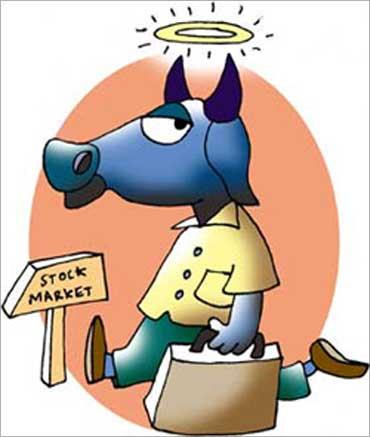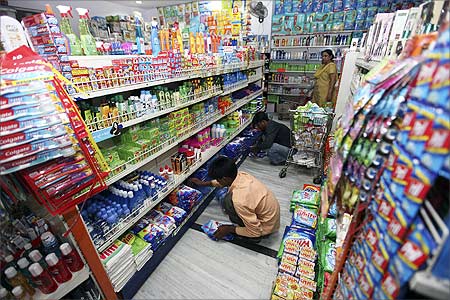 | « Back to article | Print this article |
Investing in stocks: TOP 3 sectors to watch out for in 2012
2011 was not a particularly bullish year for Indian stock market investors as the Sensex reported a fall of 23 per cent. While 2012 too begins on a pessimistic note, Salil Dhawan, editor, Investment-Mantra, suggests three sectors that could provide decent -- if not stellar -- returns in the New Year.
The year that was...
2011 was a tough year for the stock market. High inflation, higher interest rates, stalling growth led to sagging markets. Money did better short term in gold and fixed return products.
After a smart post-2008 crisis recovery in the equity market over 2009 and 2010, when the Indian equity market went up 81 per cent in 2009 and 18 per cent in 2010, the year 2011 was a complete disappointment. While global factors such as the Europe crisis and slow recovery in the US were the main triggers, inflation in India as well as delay in government policy-making were the main reasons behind India's disappointing year on the stock market.
The benchmark Sensex index fell around 23 per cent in 2011.
Negativity from global and domestic factors
On the global front, Euro debt crises, lacklustre growth in US economy, worries over Europe's growth sustenance made the headlines pulling markets into negativity.
Global factors have affected the performance of our market to some extent, but mainly domestic factors have come to haunt us. On the domestic front, policy paralysis along with various scams, declining GDP estimates, rampant inflation, rising interest rates, rising crude oil prices and poor quarterly results by India Inc. impacted markets in a negative way. High interest burden and raw material cost on the back of rising commodity inflation had also taken a toll on companies' profits. India's inflation was the biggest worry from the start of the year and the Wholesale Price Index remained consistently above 9 per cent throughout 2011 -- touching a high of 9.78 per cent in August 2011. To counter rising inflation, the Reserve Bank of India (RBI) raised interest rates six times by a total of 225 basis points last year. Additionally, the rupee saw a record fall against the dollar in 2011.
IPO market turned out to be value destroyers where 26 out of the 38 companies are trading below their offer price and losses in some scripts mounting to as large as 90 percent.
Turbulent markets shook the mutual fund market as well. Equity diversified funds lost about 22 per cent on average. Mid- and small-cap funds lost a bit more. Their average loss for 2011 stands at about 26 per cent. As markets and funds slipped lower and lower, interest rates rose and other asset classes, such as gold and bonds, saw investor inflows and higher returns.
NEXT: Where to invest in 2012?
Courtesy: Investment-mantra.in
Investing in stocks: TOP 3 sectors to watch out for in 2012
What's in store for 2012?
Investors are all but pessimistic about equities performance in the New Year. It will be impossible for any analyst to predict where the bellwether Sensex will be by December 2012. This may well turn out to be an year of consolidation wherein on the global front, the Euro zone takes some concrete steps to overcome Euro debt crises, US economy show signs of revival and growth. On the domestic front all eyes will be on Reserve Bank of India as to when it starts to cut rates and thus reversing the interest rate cycle and thus economic growth gathers steam. Inflation numbers (especially food inflation numbers) will be keenly watched all throughout the year. Investors and corporate India will also expect the government to speed up policy making process and thus fuel growth.
We look at three sectors which could possibly provide steady (if not stellar returns) over the course of 2012:
NEXT: Sectors to watch out for 2012
Investing in stocks: TOP 3 sectors to watch out for in 2012
1. Information technology
The IT sector in India has performed well in 2011 in spite of the global headwinds. The demand has remained resilient and while margin pressure was quite visible in the first half, significant depreciation of rupee against the US dollar and Great Britain Pound in the latter half of 2011 led to easing of margin pressures. Rupee has depreciated almost 15 per cent against USD and 10 per cent against GBP in the last six months leading to both higher revenue growth in rupee terms as well as improvement in margins.
Going forward, a lot would depend on how global economies shape up. A deeper crisis in Euro zone can lead to significant pressure for Indian IT services companies. Demand in US has remained strong so far but any macro shock to the slowly recovering economy will have a detrimental impact on IT demand. While weakening currency will provide some cushion to the profits, strength in demand will remain the main catalyst. Investing in frontline IT stocks could be a safe bet in a cautious 2012 market.
Investing in stocks: TOP 3 sectors to watch out for in 2012
2. FMCG
FMCG as a sector has done exceedingly well in the year 2011 and will continue to extend the good run in 2012. FMCG stocks gain prominence in times of volatility in the market and are considered a safe bet. This is the only sector that has bucked the trend in 2011, when it posted a 9.6 per cent gain by December 21.
While the Sensex declined 23.45 per cent in the calendar year-to-date, the FMCG index has risen 10.96 per cent over the same period. In effect, the sector has outperformed Sensex by over 34 per cent in 2011.
The positive trend in the FMCG sector is likely to continue as it has proven its worth in a volatile market. The sector can continue to outperform Sensex as volatility is expected to continue in the broader market. Investors can bet on this sector on the premise that growing population and rising incomes will continue to boost demand for consumer staples and allow brand owners to profit from growing domestic consumption.
Investing in stocks: TOP 3 sectors to watch out for in 2012
3. Healthcare
In the backdrop of multiple earnings opportunities targeted by the Indian companies, pharma as a sector will continue to remain positive and the valuation premium that it enjoys is justified. Stock selection would be of utmost important to pick the winners from the sector.
The main concern in this sector will be on the new pricing estimate of the government. This could lead to some amount of reservation about the profitability of these companies. The sector should also continue to do well as long as the uncertainties triggered by the rupee depreciation continue. Overall, pharma as a sector has shown steady growth thus making it a favourite bet among investors.
Conclusion
India was one of the biggest under-performers among the emerging markets in 2011. As we enter 2012, there are concerns about lower economic growth and lack of political will to push crucial policy decisions. Also, macroeconomic concerns still remain. Corporate earnings could slow down further, given the slower economic growth, which means there could be more downgrades from analysts in 2012. However, these concerns are priced in at the current levels. Year 2012 can very well be year of consolidation if all domestic and global negativities are worked upon so that we can be at a beginning of a bull run starting 2013.




